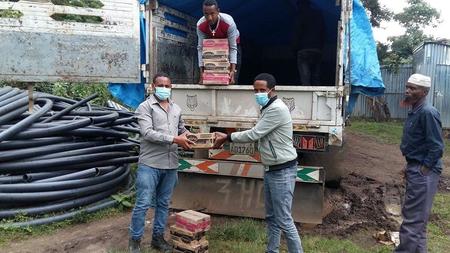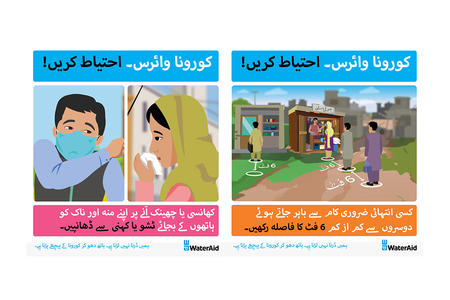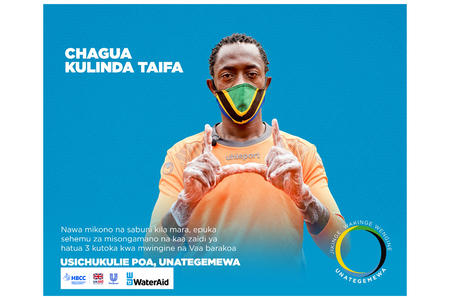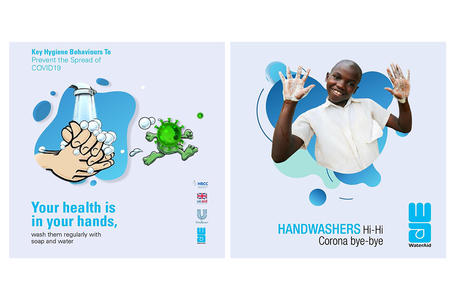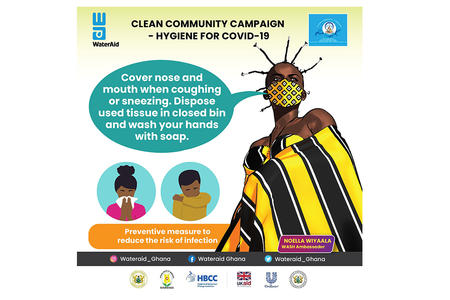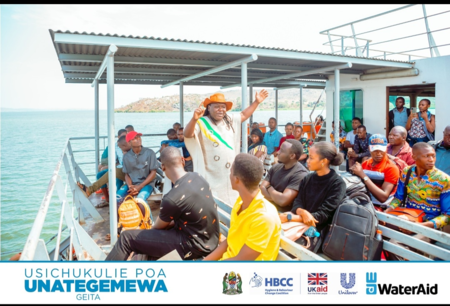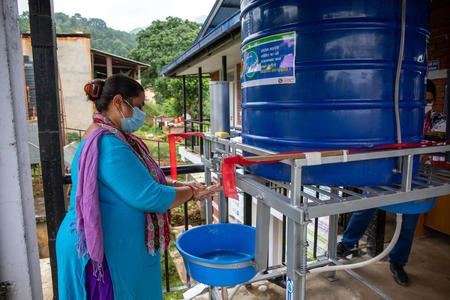Soap and celebrities: lessons in promoting hygiene behaviour change during the COVID-19 pandemic

As part of the Hygiene Behaviour Change Coalition, WaterAid teams in Ethiopia, Ghana, Nepal, Pakistan, Tanzania and Zambia responded to the COVID-19 pandemic, reaching 152 million people in less than a year. Om Prasad Gautam, Ian Gavin and Lara Kontos celebrate the achievements and reflect on key lessons.
As leaders in the water, sanitation and hygiene sector (WASH) WaterAid plays a vital role in preventing the spread of COVID-19. We promote key hygiene behaviours – such as washing hands with soap, wearing a mask in public places, cleaning frequently touched surfaces and maintaining physical distance – to help reduce the spread of the virus in the 26 countries where we work. In six of these countries, our work was funded by the Hygiene Behaviour Change Coalition. The public-private partnership operated in 38 countries and, in one year, aimed to provide hygiene products, infrastructure and awareness to one billion of the world’s most vulnerable people.
WaterAid was given £3.6 million and 1.8 million hygiene products, such as soap and hand sanitiser, to improve key hygiene behaviours and help reduce rates of COVID-19 infection in Ethiopia, Ghana, Nepal, Pakistan, Tanzania and Zambia. In total, we:
- reached 151 million people – between 20% and 70% of the entire population of each country – through mass media campaigns.
- reached 315,761 people through face-to-face community activities aimed at changing people's behaviour.
- installed 1,122 large-scale (mostly hands-free) handwashing stations to serve millions of people.
- distributed 1,811,593 Unilever hygiene products.
In some countries, responding to COVID-19 was relatively simple. We developed promotional materials, such as videos and illustrations, to encourage people to change their hygiene behaviours in response to COVID-19, and added these into existing programmes. In Nepal, for example, we updated flip charts, provided a new ‘take away’ sticker, and made new mass media assets for an ongoing behaviour change programme being delivered by health workers.
In other countries, this programme was an opportunity to work more closely with governments, re-activate a national creative committee or team, and build the experience and skills of country staff, governments and hygiene promotion volunteers.
Mass media messaging
Given how COVID-19 is spread, we recognised that our usual way of working – gathering people together to deliver community-based behaviour change activities – might put people at risk. Instead, we broadcast important messages using mass media and other non-contact means, such as announcing hygiene promotion methods through village loudspeakers.
We learned that the skills, experience and processes we normally use to develop community campaigns could be repurposed to create mass media assets, such as videos and billboard adverts. The same processes still applied: forming national creative committees and teams with governments, creative agencies and other national and international development actors to develop clear creative briefs and intervention packages.
As a result, we developed a series of progressive promotional assets. The initial TV and radio ads were traditional and knowledge based. Celebrities highlighted the importance of key hygiene behaviours, and made people aware of COVID-19 symptoms and when to self-isolate. The assets became increasingly emotional and engaging as the campaign progressed, highlighting everyone’s role in protecting their community.
Communications materials were also made relevant to each national context. In Tanzania, for example, an artist designed assets to reflect people from different ethnic groups. In Zambia, well-known musicians promoted handwashing challenges. In line with WaterAid’s commitments to equity and inclusion, the materials also included sign language and featured people with different disabilities.
More TV and radio ads
Ethiopia: Inspirational hygiene behaviour change
Ghana: Hygiene for #COVID19
Pakistan: Corona ka Dabba Gol jingle
Zambia: 'Power of Five'
Zambia: Kutuba Campaign ‘Handwashing Challenge’
Community-based behaviour change
We also worked with governments and other partners to include COVID-19 behaviours in community-based campaigns. This was the second phase of work, designed for when it was safe for people to congregate.
The campaign package included a manual as well as activities, games, competitions, demonstrations, songs and scripts to make sure each person saw a message about key hygiene behaviours between three and 12 times. Some countries already had well established and tested national behaviour change programmes, and so only needed new COVID-19 flip charts and stickers. In others, new campaigns had to be designed and tested from scratch, and were only available in the second half of 2020.
All the campaigns required training to make sure each hygiene session was delivered in the same way, using the right materials. In almost all cases, frontline health staff and community volunteers led the hygiene promotion sessions, with our supervision. These sessions were still delivered after the formal end of the HBCC programme in April 2021.
We established various monitoring mechanisms to assess the effectiveness of this response, such as regular reporting to estimate the number of people reached, and a mid-term rapid assessment of the ongoing response.
Handwashing facilities
We have installed many handwashing systems in schools and healthcare facilities over the years, but designing, testing and installing multiple, large, hands-free facilities in public places as quickly as possible was something new. Still, WaterAid country teams rose to the challenge and installed 1,122 taps and sinks in public areas.
We did not use one standard design. Instead, we worked with local organisations and universities to create locally appropriate models, which should be easier to maintain. The design was improved over time. Many countries, for example, started with temporary facilities that were cheap and quick to install, but these were not always linked to piped water systems or inclusive to people with disabilities.
We began installing these handwashing facilities within three months of signing the contract with the donor. This is relatively quick given the need for design, testing and a procurement process – and all while many countries were in lockdown. But in our haste to deliver these facilities, we failed to adequately consult with disabled and older people living in the communities. Some countries conducted disability and safety audits after the systems had been installed and modifications were made retroactively. For example, improving the path to the facility or ensuring that motorbikes cannot park close by and block access.
Installing handwashing facilities in an emergency setting was always going to be a challenge, and a mid-term evaluation showed that many didn’t have soap, and some had broken taps. As such, we worked with those responsible for maintaining them to make sure soap was always available, and that broken taps were fixed. This yielded much more positive results, and almost all facilities had soap and water at a follow-up evaluation.
Key lessons
Our programmes in Ethiopia, Ghana, Nepal, Pakistan, Tanzania and Zambia contributed greatly to national responses to fighting COVID-19. Given that most WaterAid country teams had never run a national hygiene campaign solely using mass media before, we are especially pleased to have reached more than 151 million people with engaging hygiene interventions.
Some reflections and key lessons include:
- Hygiene promotion at scale to reach people multiple times is possible, even during a public health crisis like COVID-19, but communications need to be trusted, attractive and emotional to be engaging.
- Inclusivity should be embedded from the start. Using sign language meant that our mass media materials were inclusive and positively represented people with disabilities. There were also better results where country programmes had partnerships with disabled people’s organisations. However, disability and safety audits should be applied in the early stages of the design process to make sure facilities are inclusive.
- Sustainable handwashing facilities need soap and water. We are supporting people to continually monitor those responsible for maintaining handwashing facilities.
- Mass media should be used to complement community-based behaviour change campaigns. While mass media campaigns can reach large numbers of people in a short time, it is still unclear whether they encourage people to maintain good hygiene behaviours in the long term. Mass media campaigns should therefore be used to complement community-based behaviour change campaigns, which can be implemented in a COVID-19 safe manner, with physical distancing, limited participants, and wearing a mask.
- Working with governments can make campaigns more effective. WaterAid always works with national governments to support their various behaviour change programmes, and our COVID-19 response was no different. Funding from the HBCC was used to strengthen and adapt existing government-led programmes. This made the COVID-19 behaviour change assets more effective as they had government approval and were linked to known and trusted behaviour change campaigns. Working with governments and leveraging existing partnerships is critical to reaching large amounts of people, improving hygiene behaviour change, and contributing to reducing the transmission of COVID-19 and other communicable diseases.
Om Prasad Gautam is Senior WASH Manager for Hygiene, Ian Gavin is Global Programme Manager, and Lara Kontos is Hygiene Programme Officer.
Further reading
The Hygiene and Behaviour Change Coalition
Hand hygiene: crucial to control COVID-19 and prevent future pandemics
Making hygiene behaviour change inclusive in responses to COVID-19
Top image: The 'Power of Five' messaging used in Zambia in response to COVID-19, featuring prominent sports personalities.
